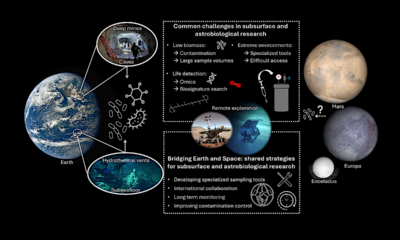Science
Geologists Uncover Possible Earliest Evidence of Animal Life

A team of researchers from the Massachusetts Institute of Technology has identified what could be the earliest known evidence of animal life on Earth. Their study focuses on chemical fossils dating back over 541 million years, providing insights into the origins of complex life forms.
This groundbreaking research highlights the significance of chemical fossils, which serve as indicators of biological activity from a time when multicellular organisms first began to emerge. The findings suggest that life forms existing during this period may have been more advanced than previously understood.
Significance of the Discovery
The fossils in question were discovered in rocks from the Cambrian Period, a crucial era in Earth’s history that marked a dramatic increase in the diversity of life. The research team utilized advanced analytical techniques to examine the chemical composition of these fossils, revealing evidence of organic molecules that are typically associated with animal life.
According to the lead researcher, Dr. James McMahon, the study has the potential to reshape our understanding of early animal evolution. “This discovery provides a glimpse into the complexity of life forms that existed long before the Cambrian explosion,” McMahon stated.
The implications of this research extend beyond academic curiosity. Understanding the origins of animal life can shed light on evolutionary processes that are fundamental to biology. It also raises questions about how early life adapted to its environment and evolved over millions of years.
Research Methodology and Findings
The researchers conducted their analysis by examining sedimentary rock samples that were collected from various locations. By employing sophisticated techniques, they were able to detect the presence of certain biomarkers, which are chemical compounds indicative of biological activity. These findings are significant because they suggest that complex life may have arisen earlier than previously believed.
This study not only contributes to the field of paleontology but also emphasizes the importance of chemical analysis in understanding ancient life forms. The researchers are now looking to conduct further studies to explore the implications of their findings in more depth.
As science continues to unlock the mysteries of our planet’s past, discoveries like these play a crucial role in shaping our understanding of life on Earth. The research from MIT provides a foundational glimpse into the complex evolutionary history that has led to the rich biodiversity we see today.
-

 Technology5 months ago
Technology5 months agoDiscover the Top 10 Calorie Counting Apps of 2025
-

 Technology3 weeks ago
Technology3 weeks agoOpenAI to Implement Age Verification for ChatGPT by December 2025
-

 Health3 months ago
Health3 months agoBella Hadid Shares Health Update After Treatment for Lyme Disease
-

 Health4 months ago
Health4 months agoAnalysts Project Stronger Growth for Apple’s iPhone 17 Lineup
-

 Health4 months ago
Health4 months agoErin Bates Shares Recovery Update Following Sepsis Complications
-

 Technology5 months ago
Technology5 months agoDiscover How to Reverse Image Search Using ChatGPT Effortlessly
-

 Technology3 months ago
Technology3 months agoElectric Moto Influencer Surronster Arrested in Tijuana
-

 Technology5 months ago
Technology5 months agoMeta Initiates $60B AI Data Center Expansion, Starting in Ohio
-

 Technology2 months ago
Technology2 months agoDiscover 2025’s Top GPUs for Exceptional 4K Gaming Performance
-

 Technology5 months ago
Technology5 months agoRecovering a Suspended TikTok Account: A Step-by-Step Guide
-

 Health5 months ago
Health5 months agoTested: Rab Firewall Mountain Jacket Survives Harsh Conditions
-

 Lifestyle5 months ago
Lifestyle5 months agoBelton Family Reunites After Daughter Survives Hill Country Floods





















